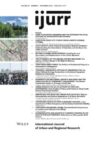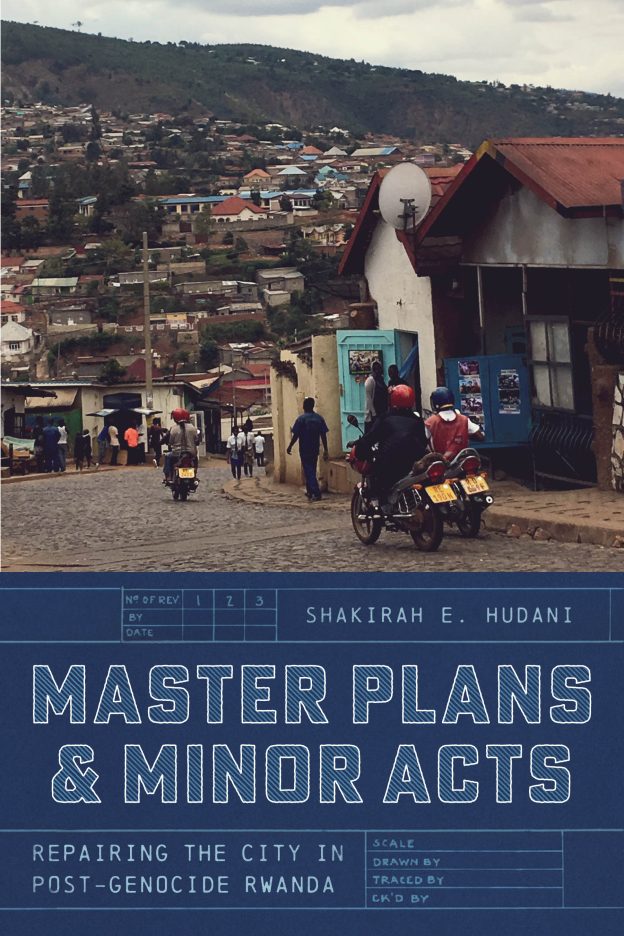Sitting at the crossroads of sociology and urban planning scholarship, Master Plans and Minor Acts by Shakirah E. Hudani is a thoughtful and nuanced exploration of social and technical planning processes and mechanisms that have shaped and continue to inform the spatiality of post-genocide Rwanda. Hudani deftly weaves together seemingly disparate elements of quotidian life and state urban planning processes in and around Kigali to articulate a holistic understanding of the nature of repair and conciliation that is taking place.
The text grapples with the inherent tension between master-planning desirous of creating an aesthetic of order, which can be at odds with the slower, more local forms of repair (the so-called minor acts in the title) that are necessary for the continuous negotiation of sociospatial conciliation in post-genocide Rwanda. It is in this context that Hudani puts forward the concept of a material politics of repair, which recognises that some harms cannot be undone, while looking to reparation and restitution as potential paths to and through restorative justice and sharing space across ethnic, communal and interpersonal lines (p. 25).
Hudani builds her case over two main sections of the book, drawing from both theory and her own qualitative longitudinal study data. The first part explores the spatial nature of conciliation and urban transformation in Kigali. It discusses the role of space in Rwanda’s reconciliation process, providing a historical context for the current urban changes. Through ethnographic examination, the book analyses the impact of the city’s master plan and the repair of homes and buildings in old neighbourhoods, highlighting how these changes affect long-term residents and the politics of memory. Master-planning here is conceptualised as a technocratic process that often erases local experiences and meaning and justifies dispossession in the name of progress. The resulting aesthetic of order limits the potential of urban areas to be spaces available for ongoing lived experiments in cohabitation and conciliation. (p. 30).
The book also examines Kigali as a site of state authority through the securitization of space, detailing the evolution of the Rwandan Patriotic Front into the ruling party and critiquing global ‘green’ development goals through the lens of Rwandan history. Hudani highlights specific sites in Kigali to illustrate how the master plan reshapes social history and built space, discussing themes of home, homeland and belonging within the context of urban reconfiguration and memory.
The second part of the book delves into the complex dynamics of urban transformation and social justice in Kigali. It examines the effects of securitization on residents’ participation and their right to remain in the city, with a particular focus on ‘unplanned’ settlements. Urban evictions and expropriations are discussed as clear indicators of a move away from urban inclusion, with the abandoned home symbolising broader struggles for political inclusion.
The impact of transnational finance and expertise on residents living on the periphery of Kigali is explored through the example of the Bugesera District, where new investments disrupt historical contexts. The section considers the limited possibilities for mobility and how local meaning and significance are overshadowed by the city’s expansion. There is also discussion of an enduring urban/rural divide, and the historical and contemporary spatial divides that reflect ethnic and regional power disparities. Via the examination of Rweru and other model green villages, Hudani questions the implications of remaking cities as selective spaces amidst these divides and the challenges this poses for genuine participatory democracy.
In the book’s conclusion, Hudani reflects on the ongoing issues of repair. She considers the broader contextual, relational and existential meanings of reckoning with the city through its regional and global connections. Critical questions are posed about cities as terrains of violence, accumulation and debt, and what it means to view the city as a reparative space. The book suggests that true repair requires confronting the multiple entanglements of violence and global influences revealed by Rwanda’s history.
Hudani’s text exposes the paradoxes in planning efforts in post-conflict and post-traumatic areas. She frames the city as at once a place of potential and rebirth and one of rupture and undoing (p. 41). This duality persists throughout the text: state visions of progress often bulldoze local repair processes, and technocratic attempts to create a new unified identity undermine the collective construction of new relational ones. Hudani’s material politics of repair suggests an emphasis on the process of repair through everyday interactions: ‘What is material is orienting; it can be grasped, exchanged, and rebuilt. The material forms the architecture of quotidian recovery. In its continuities, the existing city thus forms a habitat for an “ordinary ethics” of repair’ (p. 198).
Despite this emphasis on locality, a material politics of repair requires an awareness of the complex relationship between historical, social, economic and environmental contexts at multiple scales, from global to local. Given the extent to which planning is concerned with progress, transformation, improvement and the future, perhaps one of the most valuable insights Hudani offers is that repair does not fit neatly into an outcomes-based planning approach. Healing is not a linear process—there are spatial scars and confirmations of disaster and trauma that cannot be entirely undone; social wounds that will not fully heal.
There is still work to be done to unpack these concepts around what healing means in cases where residents embody varied perspectives, perceptions and lived experiences. Planners are called on to consider the extent to which healing might take place, and the role of the planner and planning process in facilitating that repair. If conciliation and repair are perpetually ongoing exercises that are continually renegotiated in acts of everyday living, then planners need to remain attentive to the ways in which planning and redevelopment intersect with social memory, state authority and the lived experiences of residents.
There is a delicate balance to strike between recognising the realistic limitations of repair while continuing to seek alternative paths that can promote healing. Overall, this book invites the reader to consider the pragmatics of planning for post-conflict and post-traumatic cities in a way that integrates multiple perceptions of the past and present, and therefore makes its own contribution to facilitating some degree of meaningful repair.
Nicole Lanphier, University College Dublin
Shakirah E. Hudani 2024: Master Plans and Minor Acts: Repairing the City in Post-Genocide Rwanda. Chicago, IL: The University of Chicago Press. Cover used with permission of The University of Chicago Press.
Views expressed in this section are independent and do not represent the opinion of the editors.

